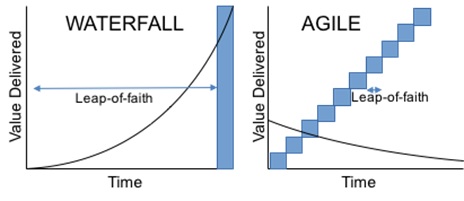Most project managers think that Waterfall is an outdated methodology replaced by Agile and its subsets. Companies are spending thousands of dollars on SCRUM masters, Agile coaching, and building the workflow which currently fits their business requirements.
The Waterfall methodology is opposite to Agile. It’s hard to manage large software projects with Waterfall. However, a lot of project managers are still using it for their projects. Yes! The Waterfall is live in 2019!
Throwbacks to the history: differences of Agile and Waterfall.
During the past 20 years, or even more, project managers of all experience levels uphold Waterfall and Agile methodologies. Both of them have their strengths and weaknesses, and if you look deeply, it’s just a project management style of software project planning.
With the Waterfall methodology, your project moves chronologically using the expected timeline. The start point is planning, and then you go forward customer approval, then coding phase, next QA, and finally release. It’s a great system where you know all the needs and requirements at the beginning of your project. However, when they are not defined – the Waterfall project fails in most cases.
On the other hand, Agile projects have a different face. Instead of planning the project at the beginning, Agile follows a more interactive approach. From the customer’s side, the process runs with small pieces delivered by the developers as fast as possible. The customer shares feedback, and the team uses it for the next chunk creation.
When your requirements are unexplored at the beginning, this style of delivery works excellent. However, the expected timeline for project completion using Agile struggles.

What are the projects where Waterfall is the best choice?
Most of the time, Waterfall is a better project management methodology. For example, you are writing software for the satellite. Agile won’t work here. And here is why:
You are delivering chunks of software, and each time it’s produced, a new satellite should fly. So, how many satellites should you launch before you have the software? The answer is hundreds and in some cases, thousands.
As you see, the circumstances influence the choice of methodology, and it’s highly important not to push agile if it’s evident that the project should be managed using Waterfall.
Here are the points you should investigate:
- All the requirements are well-known, definite, and fixed.
- You have all the resources necessary for the delivery.
- There is no need for additional researches.
- You don’t have obscure requirements.
- Your project is short.
Hybrid approaches change the face of Agile and Waterfall.
You might be probably surprised by the subheading. But a lot of companies are using the benefits of Agile and Waterfall methodologies for their projects. The hybrid approach makes it possible to apply changes effectively, nevertheless continue following the project requirements.
With the defined scope of work, it’s easier to plan the software architecture and follow a more structured approach in the development. On the other hand, by delivering pieces of code (chunks), it’s easier for the team to adapt to new features or requirements.
And the funniest fact is that most teams are using the hybrid methodology to deliver a project, but still call it Agile.
Our conclusions
We are not sure that there is a place for a classy waterfall methodology in today’s world. The issue lies in the frequency business situation changes. Everything changes each day, sometimes each minute. Nevertheless, it might live with Agile together.
A lot of software outsourcing companies are using Waterfall to evaluate costs for software development when working fixed price. Nevertheless, the process their project managers follow stays Agile.
If you are looking to start your project, contact Efisco. Our services root in helping you to pick up software development providers to building up your dedicated team of professionals.

